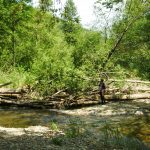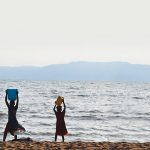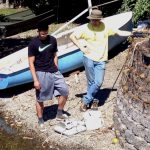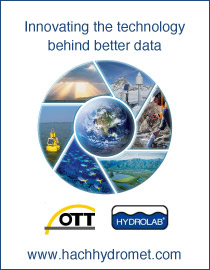Receiving the 2015 Dave Lamb Memorial Scholarship saved my thesis project
by Michelle Bahnick
I am currently pursuing a Master of Science degree in the Biology Department at Western Washington University. My project focuses on evaluating a protocol called the Stream Function Assessment Methodology (SFAM), which assesses the processes that create and maintain stream ecosystems. SFAM is currently under development by the Oregon Department of State Lands, the U.S. Environmental Protection Agency (EPA), and the U.S. Army Corps of Engineers in collaboration with Willamette Partnership. SFAM aims to provide a comprehensive stream reach assessment by combining stream attributes across a variety of spatial scales to create ratings for biological, hydrological, water quality, and geomorphological stream functions…
Kokanee research planned by 2016 Dave Lamb Scholarship winner Zach Klein
 Kokanee (Oncorhynchus nerka) is a common freshwater fish found throughout much of the world. Kokanee support valued recreational fisheries and are a food source for economically, socially, and ecologically important fishes (e.g., bull trout (Salvelinus confluentus) and rainbow trout (O. mykiss)). Despite their importance, many knowledge gaps remain regarding kokanee ecology and management. For instance, kokanee populations are commonly managed using data collected from mid-water trawls.
Kokanee (Oncorhynchus nerka) is a common freshwater fish found throughout much of the world. Kokanee support valued recreational fisheries and are a food source for economically, socially, and ecologically important fishes (e.g., bull trout (Salvelinus confluentus) and rainbow trout (O. mykiss)). Despite their importance, many knowledge gaps remain regarding kokanee ecology and management. For instance, kokanee populations are commonly managed using data collected from mid-water trawls.
Send us your nominations for the 2016 Secchi Disk Award!
 The WALPA Board is seeking nominations for the annual Secchi Disk Award to be presented at this fall’s conference in Bellingham. Each year WALPA recognizes an individual who has made an outstanding contribution to the science of lake management and protection. Let us know about a lake hero who should be honored with this year’s Secchi Disk Award.
The WALPA Board is seeking nominations for the annual Secchi Disk Award to be presented at this fall’s conference in Bellingham. Each year WALPA recognizes an individual who has made an outstanding contribution to the science of lake management and protection. Let us know about a lake hero who should be honored with this year’s Secchi Disk Award.
Lake Tanganyika: Fish diversity, nutrient recycling and periphyton productivity in the littoral zone
Adapted from an article by Dr. Yvonne Vadeboncoeur
The littoral (nearshore) ecosystem of Lake Tanganyika is the freshwater analog of a coral reef. The clear, shallow waters at the lake’s edge are low in nutrients, but the attached algae are highly productive and support the diverse fish community. Dr. Yvonne Vadeboncoeur and Dr. Peter McIntyre are studying the relationships between fish abundance, periphyton productivity and nutrient upwelling in Lake Tanganyika. They are exploring the key roles that grazing and nutrient excretion by fish play in maintaining high ecosystem production.
Chemical variations in water and sediment of lakes in the south Puget Sound region, Washington
Jeffrey Tepper, Andrew Oberhelman, and Mitchell Dodo
The South Puget Sound region contains over 500 natural lakes, many of which originated as kettles, depressions that formed as buried ice blocks melted during the last glacial retreat. Over the past 14 years, students in Environmental Geochemistry at the University of Puget Sound have been collecting and analyzing water and sediment samples from about a dozen lakes in the Tacoma–Lakewood–Federal Way area. Although these lakes vary in size and depth, all are hosted within similar glacial outwash deposits and are fed by some combination of precipitation, surface runoff, and groundwater inflows, so we initially assumed that their water compositions would be broadly similar. As our data set has grown, however, it has become clear this is not the case: each of the lakes studied has a unique chemical fingerprint that remains similar year to year.













